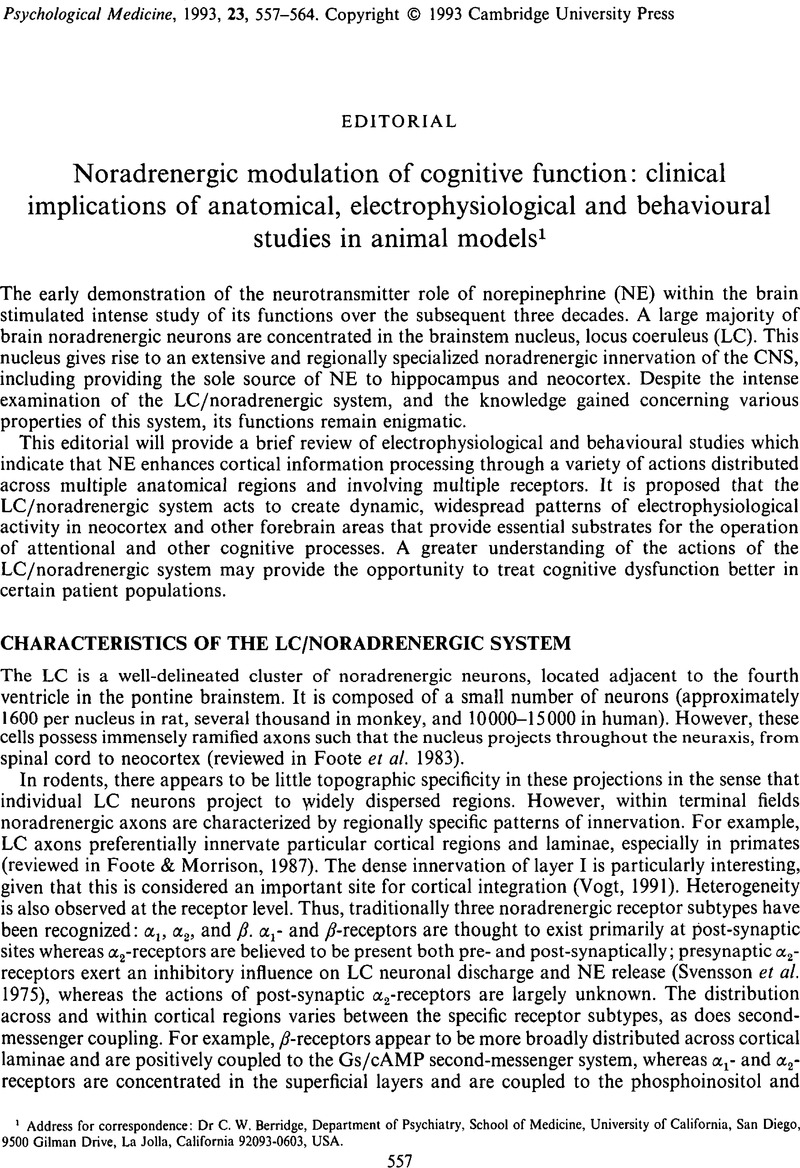Crossref Citations
This article has been cited by the following publications. This list is generated based on data provided by Crossref.
Arnsten, A.F.T.
and
Cai, J.X.
1993.
Postsynaptic alpha-2 receptor stimulation improves memory in aged monkeys: Indirect effects of yohimbine versus direct effects of clonidine.
Neurobiology of Aging,
Vol. 14,
Issue. 6,
p.
597.
Horwitz, Barry
1994.
Data analysis paradigms for metabolic‐flow data: Combining neural modeling and functional neuroimaging.
Human Brain Mapping,
Vol. 2,
Issue. 1-2,
p.
112.
PLISZKA, STEVEN R.
McCRACKEN, JAMES T.
and
MAAS, JAMES W.
1996.
Catecholamines in Attention-Deficit Hyperactivity Disorder: Current Perspectives.
Journal of the American Academy of Child & Adolescent Psychiatry,
Vol. 35,
Issue. 3,
p.
264.
Caplan, Rochelle
Guthrie, Donald
and
Komo, Scott
1996.
Blink rate in children with attention-deficit-hyperactivity disorder.
Biological Psychiatry,
Vol. 39,
Issue. 12,
p.
1032.
Willemsen-Swinkels, Sophie H.N.
Buitelaar, Jan K.
and
van Engeland, Herman
1996.
The effects of chronic naltrexone treatment in young autistic children: A double-blind placebo-controlled crossover study.
Biological Psychiatry,
Vol. 39,
Issue. 12,
p.
1023.
Schutzer, W.E.
and
Bethea, C.L.
1997.
Lack of ovarian steroid hormone regulation of norepinephrine transporter mRNA expression in the non-human primate locus coeruleus.
Psychoneuroendocrinology,
Vol. 22,
Issue. 5,
p.
325.
Harvey, Philip D.
and
Keefe, Richard S. E.
1997.
Cognitive Impairment in Schizophrenia and Implications of Atypical Neuroleptic Treatment.
CNS Spectrums,
Vol. 2,
Issue. 8,
p.
41.
Sarter, Martin
and
Bruno, John P
1997.
Cognitive functions of cortical acetylcholine: toward a unifying hypothesis.
Brain Research Reviews,
Vol. 23,
Issue. 1-2,
p.
28.
Pineda, J.A.
Westerfield, M.
Kronenberg, B.M.
and
Kubrin, J.
1997.
Human and monkey P3-like responses in a mixed modality paradigm: effects of context and context-dependent noradrenergic influences.
International Journal of Psychophysiology,
Vol. 27,
Issue. 3,
p.
223.
Coull, J. T.
Frith, C. D.
Dolan, R. J.
Frackowiak, R. S. J.
and
Grasby, P. M.
1997.
The Neural Correlates of the Noradrenergic Modulation of Human Attention, Arousal and Learning.
European Journal of Neuroscience,
Vol. 9,
Issue. 3,
p.
589.
Li, Bao-Ming
and
Kubota, Kisou
1998.
α-2 Adrenergic modulation of prefrontal cortical neuronal activity related to a visual discrimination task with GO and NO-GO performances in monkeys.
Neuroscience Research,
Vol. 31,
Issue. 2,
p.
83.
Gies, U.
Bilzer, T.
Stitz, L.
and
Staiger, J.F.
1998.
Disturbance of the Cortical Cholinergic Innervation in Borna Disease Prior to Encephalitis.
Brain Pathology,
Vol. 8,
Issue. 1,
p.
39.
Haapalinna, Antti
Sirviö, Jouni
and
Lammintausta, Risto
1998.
Facilitation of cognitive functions by a specific α2-adrenoceptor antagonist, atipamezole.
European Journal of Pharmacology,
Vol. 347,
Issue. 1,
p.
29.
Bethea, C. L.
Pecins-Thompson, M.
Schutzer, W. E.
Gundlah, C.
and
Lu, Z. N.
1998.
Ovarian steroids and serotonin neural function.
Molecular Neurobiology,
Vol. 18,
Issue. 2,
p.
87.
Lazzaro, I.
Gordon, E.
Li, W.
Lim, C.L.
Plahn, M.
Whitmont, S.
Clarke, S.
Barry, R.J.
Dosen, A.
and
Meares, R.
1999.
Simultaneous EEG and EDA measures in adolescent attention deficit hyperactivity disorder.
International Journal of Psychophysiology,
Vol. 34,
Issue. 2,
p.
123.
Riekkinen, M.
Jäkälä, P.
Kejonen, K.
and
Riekkinen, P.
1999.
The α2 agonist, clonidine, improves spatial working memory performance in Parkinson's disease.
Neuroscience,
Vol. 92,
Issue. 3,
p.
983.
Shores, Molly M
White, Sylvia S
Veith, Richard C
and
Patricia Szot
1999.
Tyrosine hydroxylase mRNA is increased in old age and norepinephrine uptake transporter mRNA is decreased in middle age in locus coeruleus of Brown–Norway rats.
Brain Research,
Vol. 826,
Issue. 1,
p.
143.
Skosnik, Patrick D
Chatterton, Robert T
Swisher, Tara
and
Park, Sohee
2000.
Modulation of attentional inhibition by norepinephrine and cortisol after psychological stress.
International Journal of Psychophysiology,
Vol. 36,
Issue. 1,
p.
59.
Knauber, Jens
and
Müller, Walter E.
2000.
Decreased exploratory activity and impaired passive avoidance behaviour in mice deficient for the α1b-adrenoceptor.
European Neuropsychopharmacology,
Vol. 10,
Issue. 6,
p.
423.
Groenewegen, Henk J.
and
Uylings, Harry B.M.
2000.
Cognition, emotion and autonomic responses: The integrative role of the prefrontal cortex and limbic structures.
Vol. 126,
Issue. ,
p.
3.



